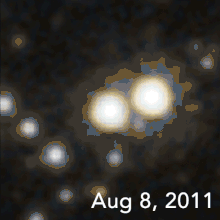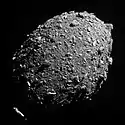OGLE-2011-BLG-0462
OGLE-2011-BLG-0462, also known as MOA-2011-BLG-191, is a stellar-mass black hole isolated in interstellar space. OGLE-2011-BLG-0462 lies at a distance of 5,000 light years in the direction of the galactic bulge in the constellation Sagittarius. The black hole has a mass between 1.6 and 4.4 M☉, but might weigh as much as 7.1±1.3 M☉[1] The discovery of OGLE-2011-BLG-0462 makes this object the first truly isolated black hole found.[2] OGLE-2011-BLG-0462 was discovered through microlensing when it passed in front of a background star that was 20,000 light years away from Earth. The black hole's gravity bent the star's light, causing a sharp spike in brightness that was detected by the Hubble Space Telescope. It took six years to confirm the existence of OGLE-2011-BLG-0462.[3] Its initial kick velocity has been estimated to have an upper limit of 100 km/s.[4][5]
 Animated astrometric observations of the gravitational microlensing of OGLE-2011-BLG-0462/MOA-2011-BLG-191 | |
| Object type | black hole |
|---|---|
| Other designations | MOA-2011-BLG-191 |
Observation data (Epoch 2455874.50236 (2011-11-09.00 UT)) | |
| Constellation | Sagittarius |
| J2000.0 (17:51:40.19) | |
| Declination | J2000.0 (-29:53:26.3) |
| Distance | 5000 light years (LY) |
| Mass | 1.6-4.4 sun |
| Estimated age | 100 million years old |
See also
References
- Mereghetti, Sandro; Sidoli, Lara; Ponti, Gabriele; Treves, Aldo (2022-06-01). "X-Ray Observations of the Isolated Black Hole Candidate OGLE-2011-BLG-0462 and Other Collapsed Objects Discovered through Gravitational Microlensing". The Astrophysical Journal. 934 (1): 62. arXiv:2206.07480. Bibcode:2022ApJ...934...62M. doi:10.3847/1538-4357/ac7965. S2CID 249674753.
- "2011-BLG-0462". ogle.astrouw.edu.pl. Retrieved 2022-06-29.
- Sahu, Kailash C.; Anderson, Jay; Casertano, Stefano; Bond, Howard E.; Udalski, Andrzej; Dominik, Martin; Calamida, Annalisa; Bellini, Andrea; Brown, Thomas M.; Rejkuba, Marina; Bajaj, Varun (2022-01-01). "An Isolated Stellar-mass Black Hole Detected through Astrometric Microlensing". The Astrophysical Journal. 933 (1): 83. arXiv:2201.13296. Bibcode:2022ApJ...933...83S. doi:10.3847/1538-4357/ac739e. S2CID 246430448.
- Panjkov, Sonja (2023-01-27). "The Peculiar Nature of Black Hole Birth Kicks". astrobites. Retrieved 2023-01-28.
- Andrews, Jeff J.; Kalogera, Vicky (2022-05-01). "Constraining Black Hole Natal Kicks with Astrometric Microlensing". The Astrophysical Journal. 930 (2): 159. arXiv:2203.15156. Bibcode:2022ApJ...930..159A. doi:10.3847/1538-4357/ac66d6. ISSN 0004-637X. S2CID 247778998.

